Thu, Apr 17, 2014
Delay Had Been Set To Expire This Month
The European Council has decided to continue to “stop the clock” on further implementation of the controversial European Union Emissions Trading Scheme (EU-ETS), while representatives to the International Civil Aviation Organization (ICAO) continue their work on a plan for addressing aircraft emissions.

The council agreed on April 14 to extend its “stop-the-clock” provision affecting non-European operators until fall 2016, when representatives at the next meeting of the ICAO Assembly are expected to move forward on an international framework for both technological and market-based emissions-curbing measures for the industry. The “stop-the-clock” provision was originally set to expire this month.
European officials originally planned to unilaterally impose EU-ETS on non-European operators beginning in 2013, with mandatory fees for emissions for the full length of flights to and from EU airports. That plan was met with considerable opposition from governments in the United States, China and other countries, which led the EU to “stop the clock” on implementation for one year.
Following that decision, ICAO agreed at its 38th triennial assembly, held last October, to move forward on the advancement of a framework for international aviation emissions policies, which pivots from the EU-ETS in key ways, including the promotion of an international dialogue focused on simple, more workable measures for addressing aircraft emissions, which could be built around various types and sizes of operators.
The European Council’s decision to continue the “stop-the-clock” policy follows earlier approval of the plan to halt EU-ETS implementation outside of Europe by the European Commission and EU Parliament. The ETS will still apply to flights operating between two points within the European Economic Area.
The announcement was praised by the NBAA. “NBAA and its Members have continually opposed onerous and unnecessary fees, taxes and regulations that severely harm the industry, which is why we have fiercely opposed the EU-ETS,” NBAA President and CEO Ed Bolen said. “We are gratified that decision makers in Europe have opted to leave in place the ‘stop-the-clock’ provision on EU-ETS.”
More News
Also: B-29 Superfortress Reunion, FAA Wants Controllers, Spirit Airlines Pulls Back, Gogo Galileo Van's Aircraft posted a short video recapping the goings-on around their reorganiz>[...]
Light Gun A handheld directional light signaling device which emits a brilliant narrow beam of white, green, or red light as selected by the tower controller. The color and type of>[...]
"The journey to this achievement started nearly a decade ago when a freshly commissioned Gentry, driven by a fascination with new technologies and a desire to contribute significan>[...]
"Our driven and innovative team of military and civilian Airmen delivers combat power daily, ensuring our nation is ready today and tomorrow." Source: General Duke Richardson, AFMC>[...]
Aircraft Conflict Predicted conflict, within EDST of two aircraft, or between aircraft and airspace. A Red alert is used for conflicts when the predicted minimum separation is 5 na>[...]
 Airborne 04.16.24: RV Update, Affordable Flying Expo, Diamond Lil
Airborne 04.16.24: RV Update, Affordable Flying Expo, Diamond Lil ANN's Daily Aero-Term (04.20.24): Light Gun
ANN's Daily Aero-Term (04.20.24): Light Gun Aero-News: Quote of the Day (04.20.24)
Aero-News: Quote of the Day (04.20.24) Aero-News: Quote of the Day (04.21.24)
Aero-News: Quote of the Day (04.21.24) ANN's Daily Aero-Term (04.21.24): Aircraft Conflict
ANN's Daily Aero-Term (04.21.24): Aircraft Conflict



